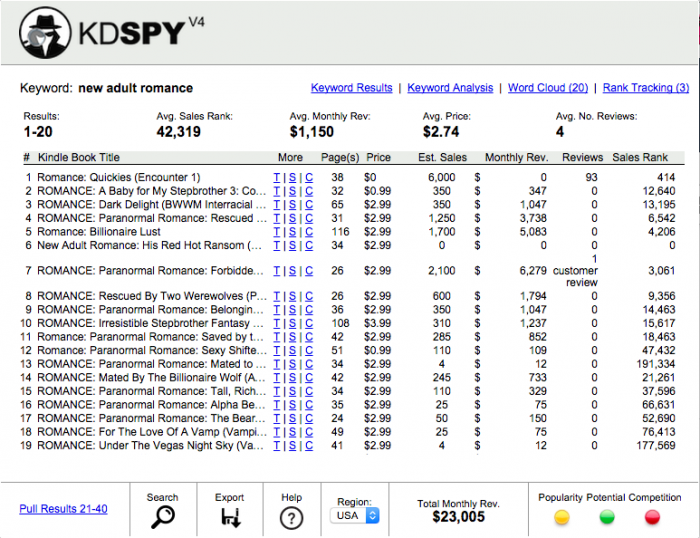KDSPY (formerly Kindle Spy): Amazon Market Research Tool
06 March 2015
A few weeks ago, I slipped in a stealth screencap from an Amazon keyword research tool I use—Wesley Atkins’s KDSPY (formerly called Kindle Spy).
Amazon searches provides a lot of interesting information if you’re an Amazon customer, but if you’re an author or publisher, KDSPY will let you know a lot more than Amazon will tell you. Like:
- Not only how well your own marketing is working, but you can track how much any Kindle author’s marketing converts into Kindle sales with the Rank tracking feature.
- Look at entire groups of books, their rankings and estimated revenue at once.
- Export information to a spreadsheet so you can watch over time.
You can use it as a tool for estimating whether to write book A or B next, for example. Or whether now is a good time, market-wise, to publish something you’ve been waiting for the right time to publish.
 If you buy KDSPY through my link, you’ll also get my own short PDF: Amazon Keywords Tricks & Tips, which will give you some insider secrets into making your book more findable via Amazon’s search. And we all know, you can’t buy something you can’t find….
If you buy KDSPY through my link, you’ll also get my own short PDF: Amazon Keywords Tricks & Tips, which will give you some insider secrets into making your book more findable via Amazon’s search. And we all know, you can’t buy something you can’t find….
The Obligatory KDSPY Screenshot

This is the top 20 Amazon hits for the phrase “new adult romance” on Amazon as of the time I took the screenshot. After I loaded the page in Amazon, I clicked on the KindleSpy icon in Chrome’s toolbar.
There are a few interesting things to note:
- The bestsellers don’t always come first. The top hits, especially the top 2, are ranked based on newness, generally. Half of the first sixteen hits were released in the last few weeks. This “new book” preference rank ensures a lot of freshness at the front, which makes it more interesting for buyers who are, as many romance readers are, heavy readers. The effect lasts 30 days, and it really hurts when that wears off. Also, relevance counts for a lot, and relevance is partly based upon keywords.
- The T, S, and C columns aren’t self explanatory. T means look at that single title in Amazon, S means do a web (Google) search with those terms, and C means do a Google image search on the cover image.
- The estimated sales is just that—estimated sales, based upon an educated guess and the book’s current sales rank. It is a moment in time.
- Sales revenue is the estimated sales times the current sales price. Note that this is also a guesstimate: that high-ranking book with a big sales revenue may have been free until yesterday, and may still be coasting on a big free bump.
Also worth noting: a borrow for a Kindle Unlimited book will bump your sales rank, but it won’t actually pay out until the reader’s read 10% of the book, which may never happen. The amount it pays out is not fixed. Essentially the pool of payable borrows is divided into the subscription fees for KU—and every author gets a surprise. - Columns are sortable. So if you really want to see how well a book of similar length to yours are doing, you can sort on that.
- KDSPY loads 20 books at a time, but you can load 100 total.
KDSPY’s a Chrome or Firefox browser extension, and it works on any Amazon Kindle searches.
 If you buy KDSPY through my link, you’ll also get my own short PDF: Amazon Keywords Tricks & Tips.
If you buy KDSPY through my link, you’ll also get my own short PDF: Amazon Keywords Tricks & Tips.
Note: Wesley’s other products are really more for non-fiction writers wanting to write to profitable niches.
Also, there are other tools for Amazon keyword research, and I’ll write about them at some other time.